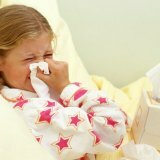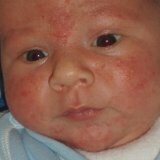Influenza: symptoms, treatment, complications and prevention
 People usually call the flu any disease that is accompanied by a cough, runny nose, fever, a sore throat.In fact, in addition to influenza, other infections related to acute respiratory viral infections( ARVI) can trigger the onset of such symptoms.The flu is all on "hearing", because it is he who is able to cause epidemics every year and lead to the development of severe complications in patients.
People usually call the flu any disease that is accompanied by a cough, runny nose, fever, a sore throat.In fact, in addition to influenza, other infections related to acute respiratory viral infections( ARVI) can trigger the onset of such symptoms.The flu is all on "hearing", because it is he who is able to cause epidemics every year and lead to the development of severe complications in patients.
Influenza In nature, there are three types of influenza viruses - A, B and C. Each of these genera has subtypes( serotypes) that differ in the antigen set( neuraminidase( N) and hemagglutinin( H)).The development of seasonal epidemics is usually associated with circulating among the population of type A viruses, as they have high variability( a tendency to mutations).Types B and C are more stable, so when they meet with them once, a person gets a stable immunity, which makes the probability of falling ill again.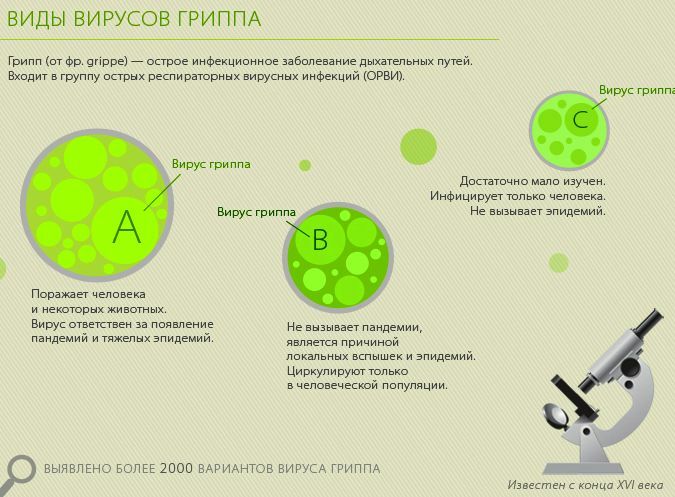
How does the infection occur?
Influenza can be infected in several ways by :
- Airborne, inhaling the virus along with droplets of mucus secreted by the patient.Promotes the activation of this path of infection, the accumulation of a large number of people in a closed space( for example, in public transport), the lack of air circulation( when the room is rarely ventilated).
- Contact( usually through the hands).The virus remains for several weeks on all objects touched by the patient, after rubbing his nose, coughing or sneezing into the palm of his hand, or on which droplets of mucus settled with the pathogen from the air.The danger in this regard is almost everything: handrails in transport, money, door handles, children's toys in kindergartens, etc.
It is also important to remember that the patient becomes infectious even before the first symptoms of the disease appear( such a latent period of the disease can last a day) and remains so for several more days after the normalization of body temperature.Therefore, it is necessary to be vigilant always, even if there are no clearly ill people nearby.
Influenza epidemic
Recommended to read:  Seasonal flu epidemics in Russia and Ukraine usually begin in December.This happens almost every year, because the pathogens of the disease are constantly changing, and the population has no immunity to them.WHO experts, observing the circulation of influenza viruses for decades, can be highly likely to predict which ones will cause the epidemic this year.This is the basis of the system of immunization against influenza( a new vaccine is created every year for specific serotypes of viruses).
Seasonal flu epidemics in Russia and Ukraine usually begin in December.This happens almost every year, because the pathogens of the disease are constantly changing, and the population has no immunity to them.WHO experts, observing the circulation of influenza viruses for decades, can be highly likely to predict which ones will cause the epidemic this year.This is the basis of the system of immunization against influenza( a new vaccine is created every year for specific serotypes of viruses).
For example, for the 2015-2017 season according to WHO for the northern hemisphere, the following viruses will be relevant:
- virus similar to A /California/7/ 2009( H1N1) pdm09;
- virus similar to A /Switzerland/9715293/ 2013( H3N2);
- virus, similar to B /Phuket/3073/ 2013( Yamagata line).
With the first virus( this is all known to the 2009-2010 pandemic swine flu) the population has already experienced, but the second and third are relatively new, that's why they should be afraid of people.For whom is the flu dangerous?
In an adult with normal immunity, the flu usually lasts no more than a week and does not leave any consequences after itself.The disease is most dangerous for young children( up to 2 years), old people, pregnant women and people suffering from chronic heart diseases, respiratory system, kidneys, blood, endocrine organs and immunodeficiencies.These categories of the population most often develop severe forms of the disease and complications.Therefore, it is they and their loved ones who are recommended by doctors for an annual vaccination against influenza.
Since influenza is especially dangerous for children, we recommend that you review this video review.The pediatrician, Dr. Komarovsky, talks about the symptoms of influenza in children and how to treat a child who is sick with the flu.
Symptoms of the flu
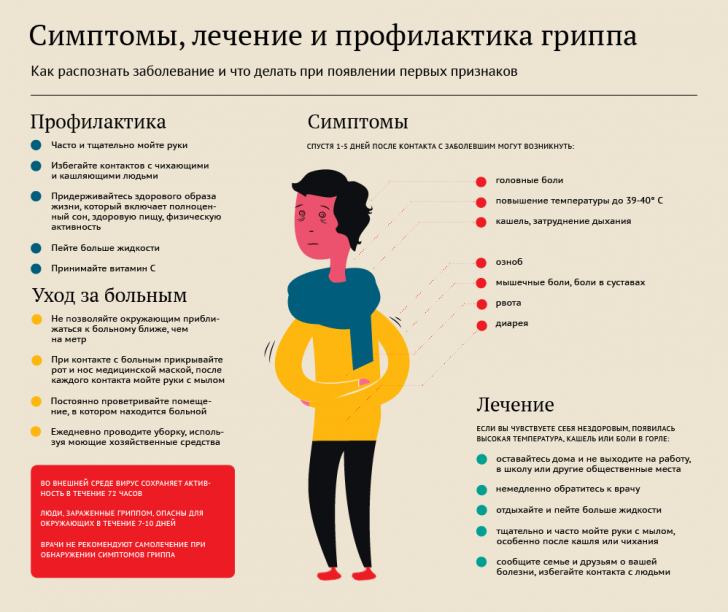 There are no specific symptoms in this disease. It is characterized by:
There are no specific symptoms in this disease. It is characterized by:
- increased body temperature;
- chills;
- aches in back, limbs;
- headache and pain in the eyes;
- catarrhal phenomena - runny nose, a feeling of "stuffiness" in the nasopharynx, a sore throat;
- cough( first dry).
Typical influenza usually begins as follows ( occurs on average 2 days after infection):
- appears aching in the body( in the muscles, in the joints), severe weakness and chills;
- temperature rises sharply( to 39-39.5 degrees);
- there is a headache.
After 1-2 days, dry cough, runny nose, sore throat.That is, for influenza, unlike other "cold" infections, the prevalence of symptoms of general intoxication over the signs of the defeat of the respiratory system is characteristic.In some patients, the disease can also pass without pronounced catarrhal phenomena.The development of complications of influenza can be suspected by the following signs: the preservation of high body temperature for more than 5 days, as well as a sharp deterioration in the patient's condition after a noticeable improvement.
It is very difficult to diagnose "Flu" to doctors without tests( such studies are conducted on rare occasions), therefore, in medical cards before the epidemic is announced, it is most often possible to see a diagnosis of "ARVI".
Complications
In itself, the flu is not dangerous, but the danger to the life of patients is its complications. They arise because the flu viruses have a specific effect on the body:
- damage small vessels( their permeability and fragility increases) and thereby disrupt the microcirculation;
- destroys tissue barriers( so toxins can freely enter the organs from the blood);
- depress local and general immunity, so it is possible to activate pathogenic and conditionally pathogenic flora.
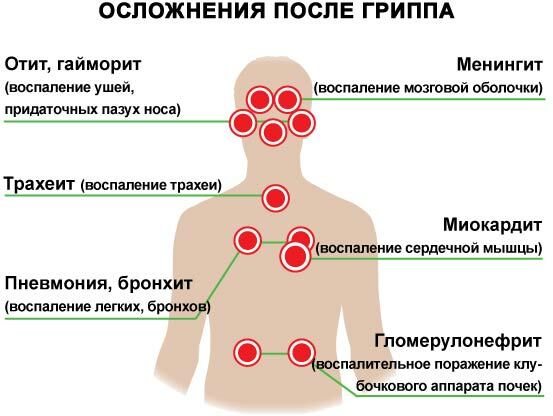 Following flu, the following complications of may develop:
Following flu, the following complications of may develop:
- Tracheitis, bronchitis, pneumonia.
- Otitis, sinusitis( inflammation of the ears and sinuses of the air, respectively).
- Myocarditis( damage to the heart muscle).
- Meningitis( inflammation of the pia mater).
- Myositis( inflammation of skeletal muscles).
- Glomerulonephritis( kidney damage).
- Organ failure( respiratory, cardiac, renal).
To the long-term consequences of the transmitted flu can also be attributed various autoimmune diseases.
Treatment of the flu
Recommended to read:Among the acute respiratory viral infections, influenza is the only disease for which specific antiviral agents have been developed.These include:
- Oseltamivir( Tamiflu).
- Rimantadine( according to WHO, it is less effective for "modern" influenza viruses).
 Apply these medications against the flu , both for treatment and for the prevention of disease( among the contact persons).However, prescribe these drugs should only a doctor.And sure that the patient really has the flu, because against other respiratory viral infections both oseltamivir and rimantadine are ineffective.More often, all flu-like diseases are treated according to a scheme that is limited to general recommendations and symptomatic therapy. Patients are assigned :
Apply these medications against the flu , both for treatment and for the prevention of disease( among the contact persons).However, prescribe these drugs should only a doctor.And sure that the patient really has the flu, because against other respiratory viral infections both oseltamivir and rimantadine are ineffective.More often, all flu-like diseases are treated according to a scheme that is limited to general recommendations and symptomatic therapy. Patients are assigned :
- .Influenza is one of the diseases that need to be "overdone".
- Abundant drink( useful fruit drinks, compotes, teas with lemon and herbs, still mineral water).This is necessary to reduce intoxication, and to maintain optimal moisture in mucous membranes.In the mucus, immunoglobulins are produced that do not allow bacteria to develop, so you can try to prevent the development of complications.
- Antipyretics( paracetamol, ibuprofen), which additionally help to reduce pain in the head, muscles, joints.You can use a combination of drugs from the flu, in addition to antipyretic components, they include antihistamines( they reduce the swelling of the mucous membranes, improve the patient's condition) and vitamin C.
- Vasodilating drops in the nose if there is a runny nose and rinsing the nasal passages with saline solutions.
- Syrups and pills for cough( with a dry cough - antitussive, with wet - mucolytic and expectorant).
- Sprays, lozenges, lollipops for sore throats.
- Inhalations.
Important: antibiotics for influenza are ineffective, it is not worth taking them and to prevent complications, this can only exacerbate the course of the disease.
Please note: such thermal procedures as hovering legs, mustard plasters do not affect the duration of the disease in any way and can not be used at elevated body temperature.
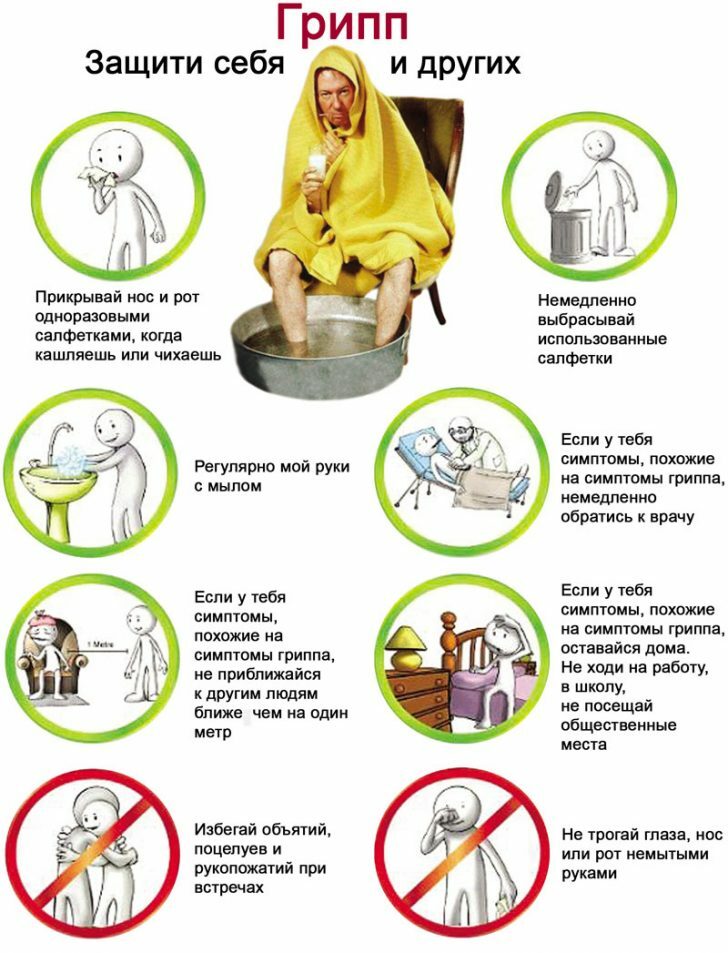 To avoid getting influenza, you need to act in two ways:
To avoid getting influenza, you need to act in two ways:
- Prevent infection - whenever possible avoid crowded places during the epidemic, do not contact sick people, wash hands frequently,Regularly hold wet cleaning, disinfect door handles, toys, etc.
- To increase the body's resistance to influenza viruses.
The second item should be given special attention.So, can be strengthened in the following ways:
-
 Strengthening local respiratory immunity.The main goal is to moisten the mucous membranes of the respiratory tract.This can be done by humidifying the air indoors, with the help of special salt solutions, which should be used to irrigate the nasal passages.You can also use special drugs that stimulate local immunity, for example, IRS-19, Broncho-munal, etc.
Strengthening local respiratory immunity.The main goal is to moisten the mucous membranes of the respiratory tract.This can be done by humidifying the air indoors, with the help of special salt solutions, which should be used to irrigate the nasal passages.You can also use special drugs that stimulate local immunity, for example, IRS-19, Broncho-munal, etc. - By creating a specific defense - when vaccinated against influenza.
- Applying various medicines, acting on immunity in general( plant immunomodulators, stimulants of interferon production, vitamin complexes, homeopathic preparations).
Among all the listed preventive measures, the most effective are, of course, the flu vaccination and the correct behavior model.No even the most modern medicines will help to prevent the development of ailment if a person during an epidemic of influenza does not adhere to the optimal way of life from the epidemiological point of view: walk more, not travel in public transport, wash and disinfect hands more often, ventilate the premises in whichLives and works, maintains cleanliness in the house, etc.
Recommended to read:Zubkova Olga Sergeevna, medical reviewer, epidemiologist


